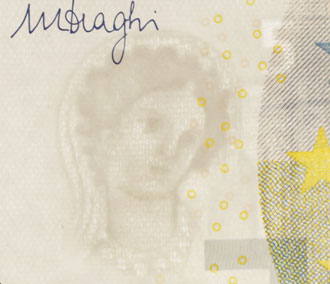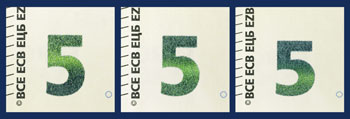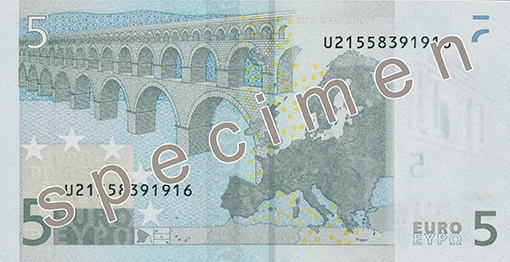French money: New 5 Euro notes
5 Euro notes have always been floppy and very worn, rather like dishrags. They are rather scarce too. Maybe that will all change with the introduction of a redsigned bill. This month the new € 5, the first of the new « Europa » series, was simultaneously released in all the countries that use the Euro. Have you seen it yet? It took us 3 weeks before we saw the first crisp new bill.
Why make a new bill? To keep ahead of conterfeiters! The Euro notes are some of the most secure bills around, but after 10 years of circulation it was time for an update. Here’s what’s new.
Security features have been improved and make notes more safe. The security features built into all new notes are easy to check with the method of « touch, look, tilt ». Look for the new watermark and hologram showing a portrait of Europa, the character from Greek mythology who gave her name to the new series of banknotes. Tilt to see the large new number 5 change color from emerald green to deep blue. Finally, small embossed lines on the left right edges allow a real bill to be detected just by touch.
These new notes are an evolution not a complete redesign. They keep the graphics and dominant colors of the first series but are easily distinguished from their predecessors. The graphics of windows and arches represent different periods of architecture. The 5 euro has classical architecture, the 10 romanesque, the 20 gothic, the 50 renaissance, the 100 baroque and rococo, the 200 iron and glass of the 19th century, and the 500 modern 20th century. The new bills have also received and extra coat of varnish and will (hopefully) become less tattered with use.
And lastly since the European Union has expanded since the original design the name of the note « euro » is now written in three alphabets: Latin (EURO) and Greek (ΕΥΡΩ) as before, but now Cyrillic characters (EBPO) have been added as Bulgaria entered the Union in 2007 even though Bulgaria does not use the Euro as official currency. The other new language variante on the bill is the initials of the Central European Banque, which is now presented in 9 variants (BCE ECB ЕЦБ EZB EKP EKT EKB BCE EBC), previously the initials had only 5 versions.
Next up the 10 € note will be redesigned and coming out in September 2014.
A few facts:
- It costs 3 to 7 cents to print each bill. This cost is completely financed by the Central Bank.
- If all the 5 euros notes printed in 2012 were put end to end they would reach nearly to the moon.
- 2 billion notes were printed for the first release of the new bill.
- La Banque de France is the biggest euro mint, printing 1.7 billion bills per year.
- A 5 euro banknote has a life span of about 13 months.
- On average, each person in the euro area makes between 300 and 400 cash transactions per year.
- According to European Central Bank estimates, in December 2012, there were approximately 15,687,189,000 banknotes in circulation around the Eurozone. That is approximately €912,593,020,200 worth of banknotes.





